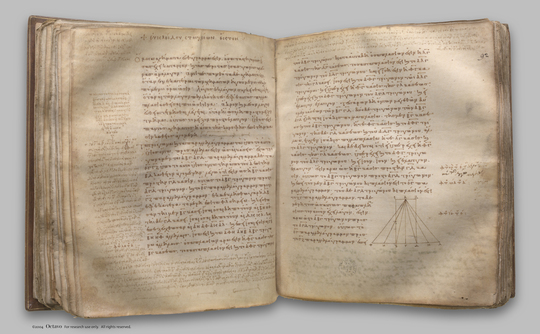
Triangles and parallelograms which are under the same height are to one another as their bases.
| Τὰ τρίγωνα καὶ τὰ παραλληλόγραμμα, τὰ ὑπὸ τὸ αὐτὸ ὕψος ὄντα πρὸς ἄλληλά ἐστιν ὡς αἱ βάσεις. Ἔστω τρίγωνα μὲν τὰ ΑΒΓ, ΑΓΔ, παραλληλόγραμμα δὲ τὰ ΕΓ, ΓΖ ὑπὸ τὸ αὐτὸ ὕψος τὸ ΑΓ: λέγω, ὅτι ἐστὶν ὡς ἡ ΒΓ βάσις πρὸς τὴν ΓΔ βάσιν, οὕτως τὸ ΑΒΓ τρίγωνον πρὸς τὸ ΑΓΔ τρίγωνον, καὶ τὸ ΕΓ παραλληλόγραμμον πρὸς τὸ ΓΖ παραλληλόγραμμον. Ἐκβεβλήσθω γὰρ ἡ ΒΔ ἐφ' ἑκάτερα τὰ μέρη ἐπὶ τὰ Θ, Λ σημεῖα, καὶ κείσθωσαν τῇ μὲν ΒΓ βάσει ἴσαι [ ὁσαιδηποτοῦν ] αἱ ΒΗ, ΗΘ, τῇ δὲ ΓΔ βάσει ἴσαι ὁσαιδηποτοῦν αἱ ΔΚ, ΚΛ, καὶ ἐπεζεύχθωσαν αἱ ΑΗ, ΑΘ, ΑΚ, ΑΛ. Καὶ ἐπεὶ ἴσαι εἰσὶν αἱ ΓΒ, ΒΗ, ΗΘ ἀλλήλαις, ἴσα ἐστὶ καὶ τὰ ΑΘΗ, ΑΗΒ, ΑΒΓ τρίγωνα ἀλλήλοις. ὁσαπλασίων ἄρα ἐστὶν ἡ ΘΓ βάσις τῆς ΒΓ βάσεως, τοσαυταπλάσιόν ἐστι καὶ τὸ ΑΘΓ τρίγωνον τοῦ ΑΒΓ τριγώνου. διὰ τὰ αὐτὰ δὴ ὁσαπλασίων ἐστὶν ἡ ΛΓ βάσις τῆς ΓΔ βάσεως, τοσαυταπλάσιόν ἐστι καὶ τὸ ΑΛΓ τρίγωνον τοῦ ΑΓΔ τριγώνου: καὶ εἰ ἴση ἐστὶν ἡ ΘΓ βάσις τῇ ΓΛ βάσει, ἴσον ἐστὶ καὶ τὸ ΑΘΓ τρίγωνον τῷ ΑΓΛ τριγώνῳ, καὶ εἰ ὑπερέχει ἡ ΘΓ βάσις τῆς ΓΛ βάσεως, ὑπερέχει καὶ τὸ ΑΘΓ τρίγωνον τοῦ ΑΓΛ τριγώνου, καὶ εἰ ἐλάσσων, ἔλασσον. τεσσάρων δὴ ὄντων μεγεθῶν δύο μὲν βάσεων τῶν ΒΓ, ΓΔ, δύο δὲ τριγώνων τῶν ΑΒΓ, ΑΓΔ εἴληπται ἰσάκις πολλαπλάσια τῆς μὲν ΒΓ βάσεως καὶ τοῦ ΑΒΓ τριγώνου ἥ τε ΘΓ βάσις καὶ τὸ ΑΘΓ τρίγωνον, τῆς δὲ ΓΔ βάσεως καὶ τοῦ ΑΔΓ τριγώνου ἄλλα, ἃ ἔτυχεν, ἰσάκις πολλαπλάσια ἥ τε ΛΓ βάσις καὶ τὸ ΑΛΓ τρίγωνον: καὶ δέδεικται, ὅτι, εἰ ὑπερέχει ἡ ΘΓ βάσις τῆς ΓΛ βάσεως, ὑπερέχει καὶ τὸ ΑΘΓ τρίγωνον τοῦ ΑΛΓ τριγώνου, καὶ εἰ ἴση, ἴσον, καὶ εἰ ἐλάσσων, ἔλασσον: ἔστιν ἄρα ὡς ἡ ΒΓ βάσις πρὸς τὴν ΓΔ βάσιν, οὕτως τὸ ΑΒΓ τρίγωνον πρὸς τὸ ΑΓΔ τρίγωνον. Καὶ ἐπεὶ τοῦ μὲν ΑΒΓ τριγώνου διπλάσιόν ἐστι τὸ ΕΓ παραλληλόγραμμον, τοῦ δὲ ΑΓΔ τριγώνου διπλάσιόν ἐστι τὸ ΖΓ παραλληλόγραμμον, τὰ δὲ μέρη τοῖς ὡσαύτως πολλαπλασίοις τὸν αὐτὸν ἔχει λόγον, ἔστιν ἄρα ὡς τὸ ΑΒΓ τρίγωνον πρὸς τὸ ΑΓΔ τρίγωνον, οὕτως τὸ ΕΓ παραλληλόγραμμον πρὸς τὸ ΖΓ παραλληλόγραμμον. ἐπεὶ οὖν ἐδείχθη, ὡς μὲν ἡ ΒΓ βάσις πρὸς τὴν ΓΔ, οὕτως τὸ ΑΒΓ τρίγωνον πρὸς τὸ ΑΓΔ τρίγωνον, ὡς δὲ τὸ ΑΒΓ τρίγωνον πρὸς τὸ ΑΓΔ τρίγωνον, οὕτως τὸ ΕΓ παραλληλόγραμμον πρὸς τὸ ΓΖ παραλληλόγραμμον, καὶ ὡς ἄρα ἡ ΒΓ βάσις πρὸς τὴν ΓΔ βάσιν, οὕτως τὸ ΕΓ παραλληλόγραμμον πρὸς τὸ ΖΓ παραλληλόγραμμον. Τὰ ἄρα τρίγωνα καὶ τὰ παραλληλόγραμμα τὰ ὑπὸ τὸ αὐτὸ ὕψος ὄντα πρὸς ἄλληλά ἐστιν ὡς αἱ βάσεις: ὅπερ ἔδει δεῖξαι. | Triangles and parallelograms which are under the same height are to one another as their bases. Let ABC, ACD be triangles and EC, CF parallelograms under the same height; I say that, as the base BC is to the base CD, so is the triangle ABC to the triangle ACD, and the parallelogram EC to the parallelogram CF. For let BD be produced in both directions to the points H, L and let [any number of straight lines] BG, GH be made equal to the base BC, and any number of straight lines DK, KL equal to the base CD; let AG, AH, AK, AL be joined. Then, since CB, BG, GH are equal to one another, the triangles ABC, AGB, AHG are also equal to one another. [I. 38] Therefore, whatever multiple the base HC is of the base BC, that multiple also is the triangle AHC of the triangle ABC. For the same reason, whatever multiple the base LC is of the base CD, that multiple also is the triangle ALC of the triangle ACD; and, if the base HC is equal to the base CL, the triangle AHC is also equal to the triangle ACL, [I. 38] if the base HC is in excess of the base CL, the triangle AHC is also in excess of the triangle ACL, and, if less, less. Thus, there being four magnitudes, two bases BC, CD and two triangles ABC, ACD, equimultiples have been taken of the base BC and the triangle ABC, namely the base HC and the triangle AHC, and of the base CD and the triangle ADC other, chance, equimultiples, namely the base LC and the triangle ALC; and it has been proved that, if the base HC is in excess of the base CL, the triangle AHC is also in excess of the triangle ALC; if equal, equal; and, if less, less. Therefore, as the base BC is to the base CD, so is the triangle ABC to the triangle ACD. [V. Def. 5] Next, since the parallelogram EC is double of the triangle ABC, [I. 41] and the parallelogram FC is double of the triangle ACD, while parts have the same ratio as the same multiples of them, [V. 15] therefore, as the triangle ABC is to the triangle ACD, so is the parallelogram EC to the parallelogram FC. Since, then, it was proved that, as the base BC is to CD, so is the triangle ABC to the triangle ACD, and, as the triangle ABC is to the triangle ACD, so is the parallelogram EC to the parallelogram CF, therefore also, as the base BC is to the base CD, so is the parallelogram EC to the parallelogram FC. [V. 11] |